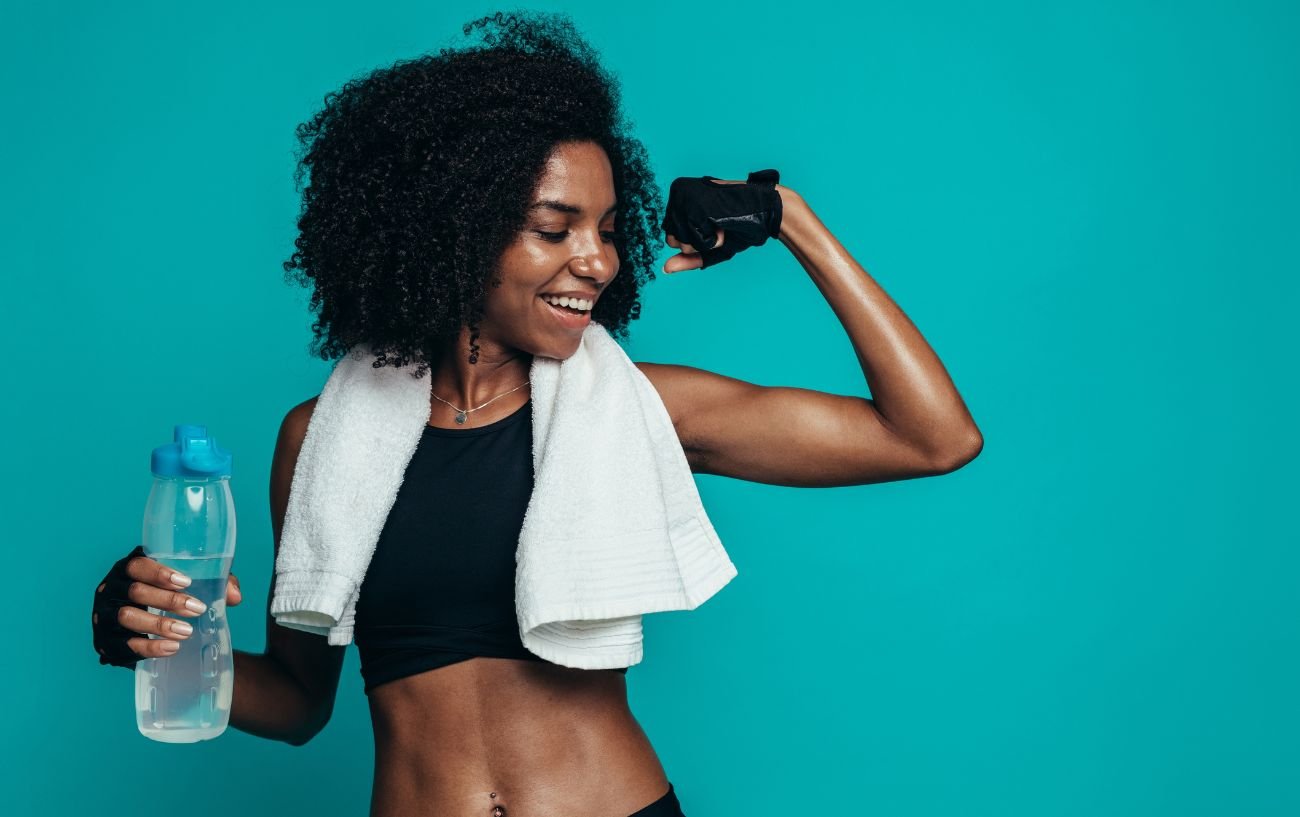Kettlebell workouts are a powerful way to build full-body strength, muscle mass, and explosive power. Many of the best kettlebell exercises engage multiple muscle groups at once, including your legs, core, and upper body, making them incredibly efficient for both strength training and conditioning.
Whether you’re looking to increase muscle, boost power, or get your heart rate up with high-intensity intervals, kettlebell training delivers results.
For runners, kettlebell exercises can be particularly beneficial, as they improve hip and core stability, build strength in key muscle groups such as the glutes and hamstrings, and enhance power and coordination for more efficient and injury-resistant running mechanics.
In this guide, you’ll find step-by-step instructions for seven of the best kettlebell exercises to help you create a well-rounded, effective strength and conditioning routine.

The Best Kettlebell Exercises For A Full Body Workout
Here are some of the best kettlebell exercises to build power and explosive strength:
#1: Kettlebell Swings
The kettlebell swing is one of the foundational kettlebell exercises, and it takes advantage of the variable center of gravity and resultant strength curve of the kettlebell.1McMaster, D. T., Cronin, J., & McGuigan, M. (2009). Forms of Variable Resistance Training. Strength and Conditioning Journal, 31(1), 50–64. https://doi.org/10.1519/ssc.0b013e318195ad32
According to a research study2ACE CERTIFIED • February 2018. (n.d.). https://acewebcontent.azureedge.net/February2018/ACE_HamstringsStudy.pdf conducted by ACE Fitness, kettlebell swings are one of the most effective hamstring exercises.
Studies have found3Edinborough, L., P. Fisher, J., & Steele, J. (2016). A Comparison of the Effect of Kettlebell Swings and Isolated Lumbar Extension Training on Acute Torque Production of the Lumbar Extensors. Journal of Strength and Conditioning Research, 30(5), 1189–1195. https://doi.org/10.1519/jsc.0000000000001215 that the kettlebell swing exercise is a highly effective movement for improving functional strength and decreasing the risk of lower back pain.
As such, almost all the best total body kettlebell workouts for strength and power include the kettlebell swing.
Here are the steps:
- Stand upright with your feet slightly wider than shoulder-width apart, gripping the horn of a moderately heavy kettlebell with both hands. Your arms should be fully extended so the kettlebell hangs in front of your body.
- Keep your heels firmly planted, but allow a gentle bend in your knees.
- Engage your core and glutes as you press through your heels and explode through your hips to drive the kettlebell upward until it’s roughly chest height and your arms are fully extended out in front of you.
- Control the kettlebell as it descends, loading your glutes and hamstrings. The kettlebell should swing back through the space between your legs somewhat.
- At the end of the arc of the swing, snap your hips forward again to drive the kettlebell back up to chest height.
- Complete 12-20 reps.
#2: Single-Arm Kettlebell Swing
You can progress from the basic kettlebell swing to a unilateral single-arm kettlebell swing.
This exercise becomes much more challenging for your core because you must maintain your shoulders and hips square and keep your spine stable, despite the load being on one side.
There will be some amount of rotation that occurs, but try to keep your core tight so that there is as close to a mirror image across your body as possible in terms of joint positioning.
To perform this exercise, follow the same steps for the regular kettlebell swing movement pattern, but hold the handle in one arm and allow the arc of the swing to come slightly towards the outside (the direction of that shoulder) as the weight comes up.
You may need to use a lighter single kettlebell to maintain proper form with your hips and shoulders level. With that said, many people mistakenly think that the kettlebell swing is primarily an upper-body exercise and tend to use too little weight.
If you’re trying to do kettlebell workouts to build strength and power, don’t be afraid to use heavier weights, because the power and momentum come from popping your hips forward. Your hips and glutes are quite strong and can support more weight than your upper body.
#3: Kettlebell Goblet Squats
One of the best kettlebell moves for leg strength, power, and hypertrophy is the goblet squat. The design of the kettlebell lends itself well to being a weighted implement when used in squats.
It is also a good beginner-friendly movement. Advanced athletes can go super heavy and focus on moving as slowly as possible.
In other words, use a kettlebell weight that you can only handle for 4 to 6 reps, but try to draw out the entire length of the set as much as you can. The slower you move, the more muscle fibers you activate, leading to greater mass and strength gains.
Here are the steps:
- Hold the sides of the handle of the kettlebell, the horns, and each hand, pressing your forearms into the bell to secure it in place as you squat. This sort of allows you to hug the kettlebell though it shouldn’t be touching your torso.
- Keep your hands slightly away from your body if you have the strength and stability to do so. This will further activate your core muscles, glutes, shoulders, and quads. The handle of the kettlebell should be just under chin level.
- Try to keep your toes pointing forward, but if your hip mobility is poor, you can angle them slightly to the outside so that you can deepen your squat.
- Bracing your core and keeping your chest up, bend your knees and sit your hips back to squat down.
- Squat as deep as possible, aiming to bring the thighs at least parallel to the floor, but the closer you can bring your butt to the floor, the better.
- Pause at your lowest position for 2 to 3 seconds, and then squeeze your glutes, hamstrings, and quads as you press through your heels to stand back up.
- Perform 6-12 reps.
#4: Double Kettlebell Front Squats
Although people typically do front squats with dumbbells or a barbell, there’s no reason why you can’t use kettlebells in a front rack position.
The kettlebell front squat is an excellent kettlebell exercise for building leg strength and hypertrophy.
Additionally, the nature of the kettlebell’s weight distribution makes it more challenging for your grip strength, as the weight hangs downward.
Here are the steps:
- Stand upright with your feet slightly wider than shoulder-width apart. Brace your core, and keep your chest up and shoulders down.
- Hold a kettlebell in each hand with your palms facing forward, hooked through the handle so that the bell is resting on your upper chest and the backs of your hands are near your shoulders or the outer portion of the collarbones on either side of your body.
- Maintain a tight grip on the horn of the kettlebell.
- Keeping your chest pressed forward, bend your knees and sit your hips back as far as possible as you lower your body down into a squat.
- When your thighs are parallel to the floor, and your knees are bent to 90°, pause and hold the bottom position of the squat for 2 to 3 seconds.
- Press explosively through your heels to return to the starting position.
- Repeat for 6-12 reps.
#5: Kettlebell Dead Cleans
The kettlebell dead clean exercise involves bringing the kettlebell from the floor up to the hand position, right at your shoulder or collarbone, in one smooth motion.
This exercise helps build explosive power and total body strength.
Depending on your current strength and training goals, you can either perform it as a bilateral or unilateral movement.
Here are the steps:
- Stand with a wide stance such that your feet are further than shoulder-width apart.
- Place a kettlebell just to the inside of your foot, near the ball of your foot.
- Keeping your core tight, chest up, and back straight, squat down, and grip the handle of the kettlebell.
- Explode through your feet so that you pull the kettlebell up to the tacked position (hand just in front of the shoulder) in one smooth motion, flipping your wrist into extension so that the palm is facing up.
- Repeat for 8-15 reps.
#6: Kettlebell Dead Snatches
This kettlebell snatch is similar to the dead clean, but the end position is straight up overhead, much like the end position of an overhead press.
As such, it’s an even more advanced kettlebell exercise for power and total body strength, requiring even more explosive force from the legs and shoulder strength.
Follow the same steps as the dead clean, but bring the weight straight up overhead in one smooth movement.
Keep your core and glutes tight to maintain a level position of your hips and shoulders, and prevent your torso from leaning to one side with the weight.
Again, work up to 12-15 reps, depending on your fitness level and goals.
#7: Kettlebell Overhead Forward and Reverse Lunge
This is one of the most challenging, dynamic, full-body exercises.
You will not only work your upper body by maintaining the overhead press throughout the exercise, but also because the weight is held unilaterally on one side, you will activate all your core muscles to maintain proper posture without leaning towards the side with the weight.
By holding the kettlebell overhead, the weight is centered directly over the quads during the forward lunge and over the glutes with a reverse lunge, helping better load these muscles for better gains.
Additionally, the hamstrings and glutes have to work harder to stabilize the lower body with the weight at a further distance from the center of mass as you move and drop up and down between the two versions of the lunge.

Here are the steps:
- Stand upright with good posture, pressing a kettlebell straight up overhead in one arm. The kettlebell will remain in this position the entire time. Make sure that your hand is straight up over your shoulder. Do not allow your arm to lean forward or back during the exercise.
- Grip the handle and allow the bell of the weight to rest on the back of your wrist.
- Keeping your core and glutes tight, your hips and shoulders level, and your spine straight, take a giant step forward with the leg on the side that is holding the kettlebell.
- Bend both knees to drop down into a forward lunge.
- When your front thigh is parallel to the ground, and both knees are bent 90°, press through your feet to return to the starting position, but instead of stepping back to standing, keep bringing your leg all the way back as you drop into a reverse lunge.
- If possible, make this all one smooth motion without touching down in the neutral standing position.
- After dropping down into your reverse lunge with the leg on the side with the kettlebell in the back, press back up to the forward lunge.
- Complete 6 to 15 reps and then switch sides.
Work up to three sets of each exercise, depending on your fitness level and training goals.
Some additional kettlebell exercises you can incorporate into your training program include Turkish get-ups, kettlebell deadlifts, thrusters, and Russian twists, all of which help develop core strength.
If you are looking for a home workout and don’t have any equipment yet, you can check out our bodyweight workout:













Thank you this excellent article. The detailed information with the videos within the article are very helpful.
Too often workout articles don’t list the exercises and want you to watch a YouTube video.